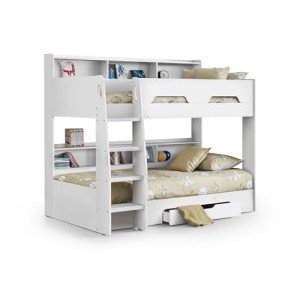Understanding UK Bunk Beds: A Comprehensive Guide
Bunk beds have become a popular choice for lots of households across the United Kingdom. They use a reliable option for saving space, accommodating multiple sleepers, and including a component of fun to a kid's space. With different styles, products, and security features offered, choosing the right bunk bed can be intimidating. This post aims to provide a thorough appearance into UK bunk beds, covering their types, advantages, safety requirements, and purchasing ideas.
The Types of Bunk Beds
When it pertains to bunk beds, the alternatives are virtually endless. The primary classifications include:
1. Requirement Bunk Beds
These are the traditional design, featuring two beds stacked one on top of the other. Basic bunk beds are best for siblings sharing a space or slumber parties.
2. Loft Beds
Loft beds rise beds without a lower bunk. This design offers adequate space beneath for a study location, additional storage, or play space for kids.
3. L-Shaped Bunk Beds
These beds have an L-shape design, enabling them to fit into corners or odd spaces in a room. They are typically ideal for larger rooms and use flexibility in sleeping plans.
4. Triple Bunk Beds
Developed for larger households, triple bunk beds accommodate three sleeping spaces. These beds provide vertical sleeping arrangements and can be an excellent option for taking full advantage of room capacity.
5. Futon Bunk Beds
These flexible beds combine a standard upper bunk with a futon or sofa below. This design can be used for sleeping or seating, making it a multifunctional option for smaller spaces.
6. Bunk Beds with Storage
Some modern-day bunk beds come geared up with drawers or shelving, offering additional storage space for clothes, toys, or books. This function is especially beneficial in rooms that require arranged storage solutions.
Advantages of Bunk Beds
Bunk beds offer numerous advantages, making them a preferable option for numerous families:
- Space-Saving: Bunk beds use vertical space, enabling more open flooring location in smaller sized spaces.
- Affordability: Sharing a space and acquiring one bunk bed can be more affordable than purchasing separate beds for several kids.
- Fun Factor: Bunk beds provide a sense of experience and excitement, particularly for kids, making bedtime more satisfying.
- Versatile Layouts: With different designs readily available, bunk beds can fit any room layout, ensuring style and performance.
- Storage Options: Many designs integrate extra storage services, helping to keep spaces neat.
| Advantages of Bunk Beds | Description |
|---|---|
| Space-Saving | Uses vertical space to maximize flooring location. |
| Affordability | More affordable for households with several kids. |
| Enjoyable Factor | Adds enjoyment to bedtime and promotes creative play. |
| Versatile Layouts | Combinations can fit various space setups. |
| Storage Options | Built-in drawers and racks assist keep products organized. |
Security Standards
When choosing bunk beds, security needs to be a leading concern, especially for children. look at here has developed policies to make sure that bunk beds fulfill particular safety standards. For instance:
- Guardrails: Beds must have guardrails on both sides of the top bunk to prevent unintentional falls.
- Mattress Size: Beds should work with a correct bed mattress size to guarantee safe usage. The bed mattress needs to not surpass the top of the guardrails.
- Durable Construction: Bunk beds ought to be made from long lasting materials to endure regular usage, ensuring stability and longevity.
- Weight Limit: Every bunk bed has a weight limitation which should be adhered to for safety factors.
- Assembly Instructions: Proper assembly is crucial; follow the manufacturer's guidelines carefully to make sure structural stability.
Buying Tips
When set to purchase a bunk bed, think about the following points:
- Room Size: Measure the room dimensions to ensure the chosen bed fits comfortably.
- Height Consideration: Ensure there is sufficient room above the top bunk to prevent bumps on the ceiling.
- Product Choice: Look for durable materials with a quality surface. Wood and metal are popular alternatives, with each using different aesthetics and toughness.
- Security Features: Verify that the bed satisfies security requirements and has appropriate guardrails and a sturdy ladder.
- Design Compatibility: Select a design that matches the existing decor of the space.
- Spending plan: Set a budget before exploring your alternatives, as bunk beds can span a large price range.
Often Asked Questions (FAQs)
1. What age is appropriate for a leading bunk?
Usually, children aged six and older can sleep on the leading bunk, however constantly check specific producer guidelines for age recommendations.
2. How do I keep my bunk bed?
Routinely check for any loose screws or parts, clean the bed occasionally, and ensure it remains stable.
3. Can bunk beds accommodate adults?
While some bunk beds are designed for much heavier weights, the majority are primarily planned for children. Check the weight limits if considering adult usage.
4. Are bunk beds easy to put together?
A lot of bunk beds include detailed assembly directions and all necessary tools. However, some designs may need professional assembly.
5. Can I use a thicker mattress on a bunk bed?
It is important to follow the maker's guidelines regarding mattress thickness to guarantee security and compliance with the guardrails.
Bunk beds are a flexible and useful choice for households aiming to optimize space and produce an enjoyable sleeping environment for their children. With a myriad of designs offered, it's important to consider the particular requirements of the household while prioritizing security and comfort. By understanding the different types, benefits, and crucial considerations surrounding bunk beds, moms and dads can make educated decisions that will boost their kids's living areas.

